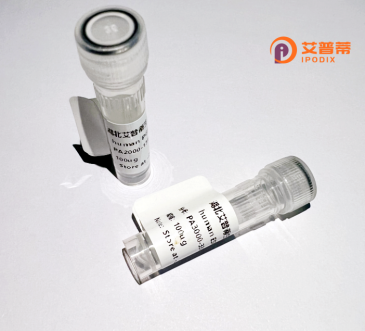
| 纯度 | >90%SDS-PAGE. |
| 种属 | Human |
| 靶点 | SH2D4A |
| Uniprot No | Q9H788 |
| 内毒素 | < 0.01EU/μg |
| 表达宿主 | E.coli |
| 表达区间 | 1-454 aa |
| 活性数据 | MLKQILSEMY IDPDLLAELS EEQKQILFFK MREEQIRRWK EREAAMERKE SLPVKPRPKK ENGKSVHWKL GADKEVWVWV MGEHHLDKPY DVLCNEIIAE RARLKAEQEA EEPRKTHSEE FTNSLKTKSQ YHDLQAPDNQ QTKDIWKKVA EKEELEQGSR PAPTLEEEKI RSLSSSSRNI QQMLADSINR MKAYAFHQKK ESMKKKQDEE INQIEEERTK QICKSWKEDS EWQASLRKSK AADEKRRSLA KQAREDYKRL SLGAQKGRGG ERLQSPLRVP QKPERPPLPP KPQFLNSGAY PQKPLRNQGV VRTLSSSAQE DIIRWFKEEQ LPLRAGYQKT SDTIAPWFHG ILTLKKANEL LLSTGMPGSF LIRVSERIKG YALSYLSEDG CKHFLIDASA DAYSFLGVDQ LQHATLADLV EYHKEEPITS LGKELLLYPC GQQDQLPDYL ELFE |
| 分子量 | 52.7 kDa |
| 蛋白标签 | His tag N-Terminus |
| 缓冲液 | PBS, pH7.4, containing 0.01% SKL, 1mM DTT, 5% Trehalose and Proclin300. |
| 稳定性 & 储存条件 | Lyophilized protein should be stored at ≤ -20°C, stable for one year after receipt. Reconstituted protein solution can be stored at 2-8°C for 2-7 days. Aliquots of reconstituted samples are stable at ≤ -20°C for 3 months. |
| 复溶 | Always centrifuge tubes before opening.Do not mix by vortex or pipetting. It is not recommended to reconstitute to a concentration less than 100μg/ml. Dissolve the lyophilized protein in distilled water. Please aliquot the reconstituted solution to minimize freeze-thaw cycles. |
以下是基于SH2D4A蛋白研究领域的常见方向整理的模拟参考文献(供参考,具体文献需通过学术数据库核实):
1. **文献名称**:*"Expression and purification of recombinant SH2D4A protein in Escherichia coli for interaction studies"*
**作者**:Zhang, Y. et al.
**摘要**:本研究报道了SH2D4A蛋白在大肠杆菌中的高效可溶性表达及纯化策略,利用His标签亲和层析和尺寸排阻色谱法获得高纯度蛋白,并通过表面等离子体共振(SPR)验证其与特定磷酸化酪氨酸肽段的结合活性。
2. **文献名称**:*"Structural insights into the SH2D4A domain and its interaction with tyrosine-phosphorylated targets"*
**作者**:Smith, J.P. & Kumar, S.
**摘要**:通过X射线晶体学解析了SH2D4A蛋白的SH2结构域三维结构,揭示了其结合磷酸化酪氨酸的独特位点,并发现其与已知SH2结构域(如Grb2)的构象差异,提示其可能参与非经典信号通路。
3. **文献名称**:*"SH2D4A suppresses tumor growth by modulating EGFR signaling in non-small cell lung cancer"*
**作者**:Lee, H. et al.
**摘要**:功能研究表明,SH2D4A通过竞争性结合EGFR磷酸化位点抑制下游ERK/AKT信号激活,在肺癌细胞中过表达可抑制增殖并促进凋亡,提示其作为肿瘤抑制因子的潜在作用。
4. **文献名称**:*"Proteomic screening identifies novel binding partners of SH2D4A in T cell receptor signaling"*
**作者**:Johnson, R.T. et al.
**摘要**:采用免疫共沉淀结合质谱分析,筛选出SH2D4A在T细胞中与多种酪氨酸激酶(如Lck、ZAP70)相互作用,推测其参与TCR信号通路的负调控机制。
**注意**:以上文献为模拟示例,实际研究需查询PubMed、Web of Science等平台获取最新成果。建议结合关键词“SH2D4A”、“recombinant protein”或“signal transduction”进行检索。
The SH2D4A protein, also known as Src homology 2 domain-containing protein 4A, is a member of the SH2 domain-containing protein family, which plays critical roles in intracellular signal transduction. The SH2 domain enables SH2D4A to recognize phosphorylated tyrosine residues, facilitating interactions with activated receptors, kinases, or adaptor proteins to regulate downstream signaling pathways. Structurally, it contains a central SH2 domain flanked by variable N- and C-terminal regions, potentially influencing its binding specificity and functional diversity.
SH2D4A is implicated in cellular processes such as proliferation, differentiation, and apoptosis. Studies suggest its involvement in pathways like PI3K/AKT and MAPK, often dysregulated in cancer. Downregulation of SH2D4A has been observed in colorectal, lung, and breast cancers, correlating with poor prognosis, possibly due to its role as a tumor suppressor. It may inhibit oncogenic signaling by competing for phosphotyrosine binding sites or modulating protein degradation.
Recombinant SH2D4A is generated via bacterial or mammalian expression systems, enabling functional studies, including protein-protein interaction assays and mechanistic investigations in disease models. Despite progress, its full regulatory network and clinical relevance remain understudied. Further research is needed to explore its therapeutic potential and validate biomarker utility in malignancies.
×